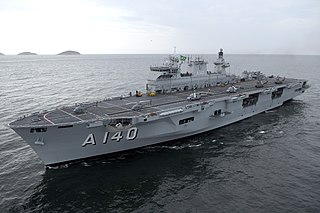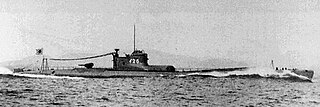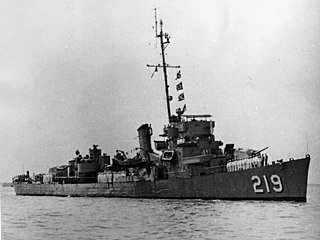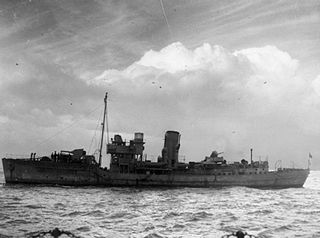Related Research Articles

USS Bullhead (SS-332), a Balao-class submarine, was the last US Navy ship sunk by enemy action during World War II, probably on the same day that an atomic bomb was dropped on Hiroshima. She was the only ship of the United States Navy to be named for the bullhead.

The Fletcher class was a class of destroyers built by the United States during World War II. The class was designed in 1939, as a result of dissatisfaction with the earlier destroyer leader types of the Porter and Somers classes. Some went on to serve during the Korean War and into the Vietnam War.

Landing platform helicopter (LPH) is a term used by some navies to denote a type of amphibious warfare ship designed primarily to operate as a launch and recovery platform for helicopters and other VTOL aircraft. As such, they are considered a type of helicopter carrier.

USS Pecos (AO–6) was a Kanawha-class replenishment oiler of the United States Navy. She was commissioned in 1921 and sunk by Japanese aircraft south of Java on 1 March 1942.

The Type B1 submarine, also called I-15-class submarine was the first group of boats of the Type B cruiser submarines built for the Imperial Japanese Navy (IJN) during the 1940s. In total 20 were built, starting with I-15, which gave the series their alternative name.

USS J. Douglas Blackwood (DE-219), was a Buckley-class destroyer escort in service with the United States Navy from 1943 to 1946 and from 1951 to 1961. She was sunk as a target in 1970.

Subic Bay is a bay on the west coast of the island of Luzon in the Philippines, about 100 kilometers (62 mi) northwest of Manila Bay. An extension of the South China Sea, its shores were formerly the site of a major United States Navy facility, U.S. Naval Base Subic Bay, now an industrial and commercial area known as the Subic Bay Freeport Zone under the Subic Bay Metropolitan Authority.

USS Muliphen (AKA-61/LKA-61) was an Andromeda-class attack cargo ship in service with the United States Navy from 1944 to 1970. She was sunk as an artificial reef in 1989.
USS Skill (AM-115) was an Auk-class minesweeper acquired by the United States Navy for the dangerous task of removing mines from minefields laid in the water to prevent ships from passing.

USS PGM-17 was a PGM-9-class motor gunboat built for the United States Navy during World War II. She was laid down and launched as USS PC-1189, a PC-461-class submarine chaser, but was renamed and reclassified before her November 1944 commissioning. She ran aground near Okinawa in May 1945. She was salvaged a month later, but was never repaired. She was towed to deep water and sunk in October 1945.
HMS Nyasaland (K587) was a Colony-class frigate of the United Kingdom that served during World War II. She originally was ordered by the United States Navy as the Tacoma-class patrol frigateUSS Hoste (PF-83) and was transferred to the Royal Navy prior to completion.
HMS Garlies (K475) was a British Captain-class frigate of the Royal Navy in commission during World War II. Originally constructed as the United States Navy Evarts-class destroyer escort USS Fleming (DE-271), she served in the Royal Navy from 1943 to 1945 and in the U.S. Navy as USS Garlies (DE-271) from August to October 1945.

HMS Gore (K481) was a British Captain-class frigate of the Royal Navy in commission during World War II. Originally constructed as the United States Navy Evarts-class destroyer escort USS Herzog (DE-277), she served in the Royal Navy from 1943 to 1946.

USS Blackford (APB-45) was a Benewah-class self-propelled barracks ship that was in service with the United States Navy during the waning days of World War II. She was decommissioned in April 1947 and sold for merchant service. In c. 1968-1970, she was sunk as a target by the South African Military.
The following index is provided as an overview of and topical guide to Wikipedia's articles on recreational dive sites. The level of coverage may vary:

Recreational dive sites are specific places that recreational scuba divers go to enjoy the underwater environment or for training purposes. They include technical diving sites beyond the range generally accepted for recreational diving. In this context all diving done for recreational purposes is included. Professional diving tends to be done where the job is, and with the exception of diver training and leading groups of recreational divers, does not generally occur at specific sites chosen for their easy access, pleasant conditions or interesting features.

HMS Hibiscus was a Flower-class corvette, built for the Royal Navy during the Second World War, and was in service in the Battle of the Atlantic. In 1942 she was transferred to the United States Navy as part of the Reverse Lend-Lease arrangement and renamed USS Spry, one of the Temptress-class gunboats. With the end of hostilities she was returned to the Royal Navy and sold into mercantile service.

HMS Periwinkle was a Flower-class corvette, built for the Royal Navy during the Second World War, and was in service in the Battle of the Atlantic. In 1942 she was transferred to the United States Navy as part of the Reverse Lend-Lease arrangement and renamed USS Restless, one of the Temptress-class gunboats. With the end of hostilities she was returned to the Royal Navy and sold into mercantile service.
References
This article incorporates text from the public domain Dictionary of American Naval Fighting Ships .